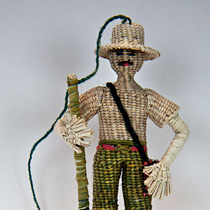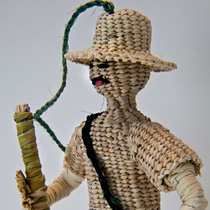Description of Figure/Doll
Male figure made entirely with woven palm fronds. He is wearing a Panama style hat, and his facial features are woven into his head. He is wearing green woven pants and has pink straw sandals. He is holding a large pole covered with plant fiber. He has a satchel with a shoulder strap hanging at his waist.
Link to higher resolution images at ClipPix
Ecuador
Location: South America
Capital: Quito
Main language: Spanish
Currency: US Dollar
Figure/Doll
Construction: palm fronds
Height in Centimeters: 13
Height in Inches: 5


Anchua Tribe in Ecuador Amazon Forest vs. the Big Oil Companies
Reading Level: 5.90
My name is Pepe and I live in Quito, the capital of Ecuador. Ecuador is in South America; south of Columbia and north of Peru. My county is called Ecuador because it is located on the equator.
Recently my uncle invited me to go with him to Amazon forest. The Amazon rainforest covers about 1/3 of Ecuador. My uncle is an anthologist – he studies how different people live. His goal is to meet some people in the Achuar tribe.
We flew in a small plane and landed on a dirt runway in Chichirat. Our guide, Shaki, met us there. Next we traveled one hour in a canoe to get to the village of Tiinkias. The Achuar live in the forest without electricity, stores, or cars. They eat native plants, fruit trees, fish. They also hunt wild pigs and other animals. They use blowguns with darts made from palm fronds. They are happy with their lives and just want to be left alone.
We stayed in a tent that night and slept on a bed of palm leaves. The next morning, the roosters woke us at dawn. I didn’t mind getting up early because Shaki was taking us on a hike through the jungle. I noticed that he had his long blowgun just in case we encountered some danger.
The trek through the jungle was amazing! My uncle said the Amazon forest has over 300 different animals, 1600 birds, 800 fish and 350 reptiles. There are also thousands of insects. Thank goodness we had insect repellant! I was very busy taking pictures of monkeys, sloths, otters, and pigs (called peccary). I also saw an animal that looked like a mixture of horse and rhinoceros (tapir). There was another one that looked like a VERY large rat (capybara). Our guide pointed out macaws, toucans, and a harpy eagle! This was so much better than a zoo. These birds and animals had no cages.
As I marveled at the beauty, Shaki complained, “This is the area the oil companies want to destroy.” “How sad,” I thought, “it would be to destroy this beauty and these peaceful people.”
When we returned to the small village it was already dark. As Shaki sat on a chair sounded by his family, he said, “We love it here near the river. As you can see, we have everything we need.”
The next day the roosters woke us up early for our departure. Shaki brought several coconuts to the canoe. That way, we could drink the milk and eat the fruit on the way to the airport. As we said goodbye, both my uncle and I thanked Shaki. We also promised to help the Achuar people who are living so peacefully with nature.




